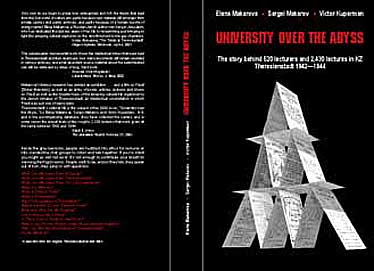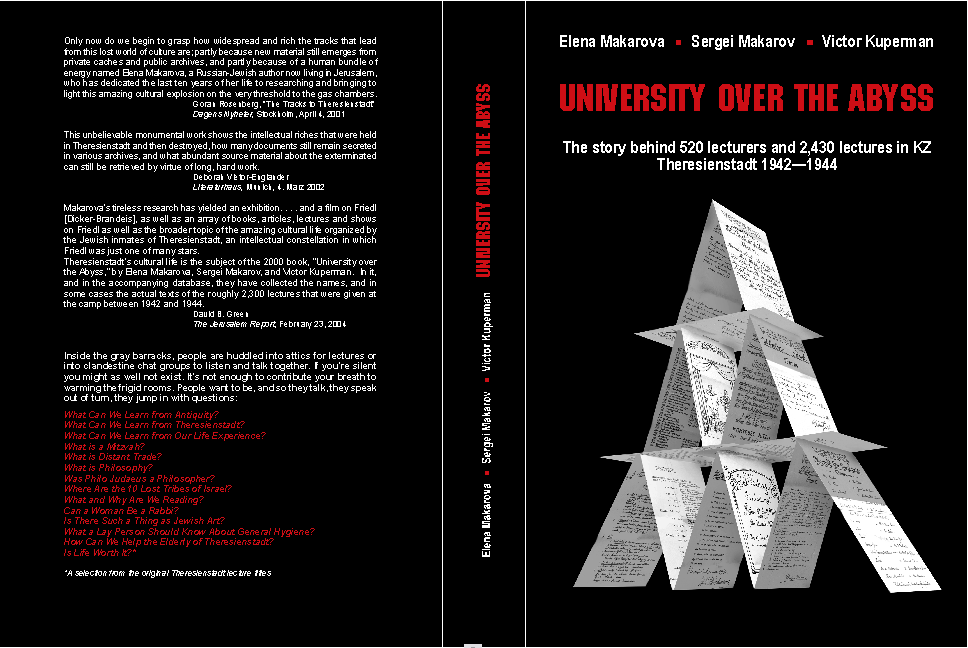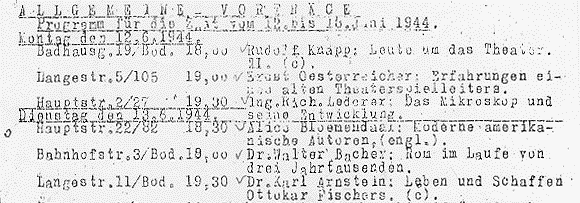
Current view
of Terezin fortress from the south east.
The header of this page uses the fragment of notes for the lecture On the Border of Science and Medicine,
by Karel Fleischmann.
|
THE UOA
Preface:
Prof. Yehuda Bauer. The volume put together by Elena Makarova, Sergei Makarov and Victor Kuperman is a great memorial to a lost culture: basically, the Central European Jewish culture destroyed by National-Socialist Germany. Yehuda Bauer Academic Advisor, International Institute for Holocaust Research, Yad Vashem, Israel; Member of the Israeli Academy of Science; Emeritus Professor of Holocaust Studies at the Hebrew University
The 2nd edition has been reedited, corrected and extended by reactions and new inputs of the readers; a new chapter, The Laughter of the Helpless, has been written, about ingenious humor and satire of the prisoners. It was also redesigned which made reading easier. The book consists of five sections: Terezin Walking Scenario is
an imaginary tour of the ghetto in the Fall 1943 based on a manuscript by prisoner Hugo Friedmann (a novelette by Elena Makarova).
Free Time in Prison is an
overview of the entire lecturing system at the ghetto, including groups and
fields, like music, art, etc. The portraits of some lecturers are given in
passing. To Sketch the Contour of the
Shadow consists of 18 complete stories of outstanding lecturers who
perished. Voices and Faces includes
eleven Elena’s interviews with survivors who either lectured or attended
lectures. Lexicon lists titles of 2430 lectures, and short biographies for each of the 520
lecturers. You may order the book by writing us an email to
makarovaelena1810@gmail.com
|
||||||||||||||||||||||||||||||||||||||||||||||||||||||||||||||||||||||||||||||||||||||
|
Introduction "It is great here, so many interesting people. One
could live here quite decently, if not for the constant fear of being sent to
the East" -- Friedl Dicker-Brandeis, artist, designer, art teacher, and
Holocaust martyr, wrote in a postcard sent from Ghetto Theresienstadt, in
1943. Theresienstadt (Terezin), an 18th century fortress near
Prague, was converted by the Nazis into a transit point, where deported Jews
were interned, sometimes as long as two years, and then sent to the
extermination camps. The prisoners were mainly professional people from Czechoslovakia, Germany,
Austria, Holland and Denmark, many of them a part of the European cultural
elite. But the cliched image of a 'pitiful Jew', crushed by a
'demonic force', didn’t hold in Terezin. Despite miserable conditions and numerous deaths from
starvation and diseases, the prisoners never gave in. In this surrealistic
world on the edge of life and death, exhausted by hunger and severe conditions, they stubbornly
clung to their cultural values - books, art, music, intellectual debate,
humor and irony. Volumes have been written about the culture in
Theresienstadt. Inspired
operas and musical pieces that originated there are widely performed.
Drawings by children and adult artists, camp magazines and poems have been
published. The children in Terezin were educated and cared for by excellent
teachers and social workers. They regained their will to live and hope for
the future, but, with few exceptions, were ruthlessly exterminated. In addition to that, hundreds of professionals and academics gave
thousands of lectures on all imaginable cultural and scientific subjects. In
the documents that survived the war, many of them explain the main motivation
for this work - first, to prepare and educate the youth for the post-war
life; and second - to revive their own professional self-esteem and replace
the misery of physical existence with the richness of spiritual life. |
||||||||||||||||||||||||||||||||||||||||||||||||||||||||||||||||||||||||||||||||||||||
|
|
||||||||||||||||||||||||||||||||||||||||||||||||||||||||||||||||||||||||||||||||||||||
|
Detail from: Karel
Fleischmann, Cultural Lecture, 1943, |
||||||||||||||||||||||||||||||||||||||||||||||||||||||||||||||||||||||||||||||||||||||
|
Lectures substituted teaching forbidden by the Nazis.
Delivered in scattered miserable attics and cellars, however cold or hot the
weather, the lectures took the shape of full courses in history, philosophy,
art, literature, medicine, science, Judaism and other fields. They attracted
tens of thousands of young people and adults, hungry and exhausted after
their day’s work - the triumph of human dignity and integrity in the face of
death. The inmates had to report to the Nazis of all cultural
activities that took place in the camp. Ironically, the survived reports
proved a precious source to recover data for thousands of lectures -
including their titles, time and locations. Some of the speakers were well-known before the war in
their own right, for example, Dr. Leo Baeck, Chief Rabbi of Germany, Alfred
Meissner, Minister of Masaryk Government in Czechoslovakia, and composer
Viktor Ullmann. Others survived the Holocaust and found wider recognition
afterwards, like psychologist Viktor Frankl, historian Miroslav Karny, writer
Josef Bor (Bondy), and author Norbert Fried. But the majority perished. Their
careers stopped short, together with their lives; they were simply forgotten.
They were such fascinating people as the Jewish philosopher Jehuda Palache,
the psychologist Max Brahn, the art historian Max Bohm, the classical
philologist Maximillian Adler, the psychologist Gertrude Boeml, the art
collector Hugo Friedmann, the journalist Philipp Manes, and the semitologist
Moizis Woskin. Below just a tiny fragment of
their exuberant intellectual world is reproduced:
|
||||||||||||||||||||||||||||||||||||||||||||||||||||||||||||||||||||||||||||||||||||||
|
|
||||||||||||||||||||||||||||||||||||||||||||||||||||||||||||||||||||||||||||||||||||||
|
Detail from:
General Subject Lectures, Program for the period from 12 to 18 of June 1944, |
||||||||||||||||||||||||||||||||||||||||||||||||||||||||||||||||||||||||||||||||||||||
|
Idea and research by Elena Makarova The Terezin
prisoners' * *
* Since University Over The Abyss came into being, the authors suddenly found themselves amidst seething public debate. To some, showing the “optimistic side” of the Holocaust looked almost blasphemous, while the others hailed the issue of the unarmed, intellectual resistance and saving dignity (if not life) as very important and instructive. Whatever the truth, the impact of the website and the book surpassed all expectations. What follows, is just a couple of the numerous feedbacks the authors received:
Arnost Lustig, Professor, Department of Literature, The American University, Washington …I got both of your works, the book [University Over The Abyss] and the magazin [2001 Magazine-catalogue about theater in KZ Terezin]. It is very, very interesting, both. I kept reading 2 nights. It’s also helpful – you see Ther. [esienstadt] from a special angle – and it gives you some additional – better feelings about the past. Jan Rocek Wilmette IL, USA Feb. 22, 2001: …We learned so many new things about the life in Terezin - it is like if we had been one of the proverbial blind men trying to describe an elephant. We knew nothing about the Manes group, the Talmudkommando, did not even know about the existence of "Shalom on Friday" [humor magazine] and of dozens of other activities which you have so skillfully recorded. NB: Both Arnost Lustig and Jan and Eva Roceks are survivors of Terezin and other camps. * * * Linked Projects: Czech edition of University Over The Abyss appeared in Prague in 2002 (G+G Publishers). A Russian series of four Terezin history volumes has been published in 2003 - 2008. The first volume, The Fortress of Deceit: Terezin Diaries1942-1945, has been issued in 2003 (408pp., Bridges of Culture, Moscow/Jerusalem); the next volume I Am a Wandering Child: Life, Literary and Art of Terezin Children appeared in July 2005. The last volumes, Terezin Lectures, and Art Against Destruction: Theater, Music and Visual Arts in Terezin 1942-1945 appeared in 2005 and 2008 respectively. Czech edition of I Am a Wandering Child ( Pevnost nad propastí. Já, děcko bloudící?, Bergman, Praha, 540 pp. ) was published 2009 . The authors will be thankful for every comment and/or additional information which may be included in the books. Any donations and contributions regarding the above projects will be readily welcomed by Elena Makarova Initiatives (NPO The House of Janusz Korszak in Jerusalem.) (See About Us)
Credits: The University Over the Abyss project has been since 1990 supported by: Leo Baeck Institute, Jerusalem; Terezin Initiative Association, Prague; Simon Wiesenthal Center, LA; Rich Foundation, the USA; Academy of Science and Humanities, Israel; Memorial Foundation for Jewish Culture, USA; Felix Posen Foundation, Switzerland; Hanadiv Charitable Foundation, Britain; Conference on Jewish Material Claims Against Germany, USA; William Gross, Israel; Pär Stenberg, Sweden; Prof. Edith Kramer, USA, and other donors.
|
||||||||||||||||||||||||||||||||||||||||||||||||||||||||||||||||||||||||||||||||||||||



